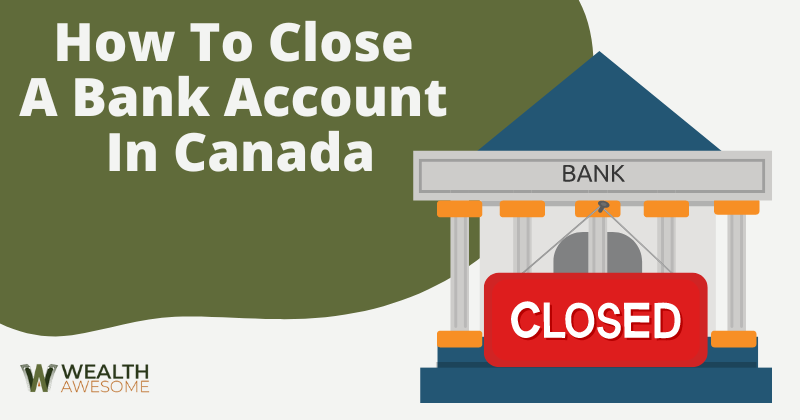With around 90% of Canadians enrolled in online banking through their financial institutions, banking has become easier than it’s ever been in the past.
However, there are still issues, complaints, and circumstances that may call for closing your account and switching to a new bank.
In today’s post, I’ll show you exactly how to close a bank account in Canada. Whether you’re switching to a low-fee online bank, moving out of the country, or just moving to another province, then you’ll learn how to close your bank account the smart way.
I promise that it’s not as hard as it may seem at first.
How Do I Close My Canadian Bank Account?
If you’ve been with the same bank for a long time, then closing your bank account in Canada may seem like a bit of a hassle.
You may have been using your bank to receive direct deposits from your employer, deposits from the government, and may also have automatic withdrawals for bills, utilities, and other subscriptions you’re signed up for.
That’s why I always recommend having another bank account lined up before you close your existing bank account. As a Canadian, you need to maintain a bank account to stay on top of bills, get paid, and store your money safely.
That being said, here’s a brief overview of how to close your bank account in Canada:
- Research banks and find a good replacement for your existing bank account
- Open a new bank account that you plan on switching over to
- Switch over any automatic withdrawals and deposits to the new account
- Settle unpaid balances and debts with your old bank account
- Transfer the money from your old bank account to your new bank account
- Wait for 30 days to ensure there aren’t any problems
- Permanently close your old Canadian bank account
I’ll go over each of these steps in more detail below. If you’ve never closed a bank account in Canada before, then these steps may seem like a lot of work.
However, if you take a methodical approach to each of them, closing your bank account should be relatively easy and painless.
How To Close A Bank Account In Canada: Step-by-Step
Now that you know the basic steps, here’s my step-by-step guide on how to close a bank account in Canada. All in all, the process shouldn’t take longer than a month, and most of the work can be accomplished in less than a week.
The good news is that you can start the process now!
1. Research & Figure Out A New Bank Account
If you already have another bank account, then skip this step.
If you plan on closing your existing bank account, you’ll want to have a new banking organization lined up so that you can switch over your finances, bills, direct deposits, and more.
If you’re unsure, then check out my guide to the best banks in Canada, so you can find a bank that best meets your needs.
2. Sign Up For Your New Bank Account
Once you’ve done your research, go ahead and sign up for your new bank account. Most new accounts will require you to make an initial deposit (typically $100 to $200) to open your account.
You can usually withdraw this money from an ABM immediately afterwards if you really need it.
3. Switch Your Automatic Withdrawals & Deposits To Your New Account
Next, you’ll want to spend some time going through your past two months’ worth of bank statements from your existing bank account. Use a highlighter and highlight any recurring or automatic withdrawals and deposits.
Before closing your bank account, you’ll need to switch all of these automatic debits over to your new account.
You don’t want your employer sending your paycheque to your closed bank account or having to pay overdraft fees when your credit card payment is auto-drafted from your old bank account.
Both of these instances can prevent your account from being closed and may result in additional fees.
4. Settle Any Unpaid Balances On Your Old Bank Account
Before closing your existing bank account, your bank will usually require you to settle unpaid balances or debts that you may have. This usually doesn’t apply for loans and mortgages, which are separate from your primary bank account.
However, if your bank account balance is negative or in default, you’ll need to clear the balance before shutting your account down.
5. Withdraw Or Transfer Your Funds From Your Old Bank Account To Your New Account
Next, you’ll need to transfer your money from your old bank account to your new bank account. To be safe, I recommend performing an electronic transfer, so you don’t have to worry about walking around with a pocket full of cash.
Leave just enough money in your account to cover any monthly bank fees that may arise over the course of the next 30 days.
6. Wait 30 Days
After withdrawing your money, I recommend waiting 30 days before permanently closing your account. This helps to ensure that you didn’t forget about any automatic debits or payments, and allows you to address them before shutting the account down for good.
7. Permanently Close Your Old Bank Account
As long as there’s been no activity in your account for the past 30 days, then you can safely close your old bank account down. Most physical banks require you to visit a branch in-person to do this.
If you’re with an online bank, then you should be able to close your account down by speaking to a representative over the phone.
Reasons Why You May Want To Close Your Bank Account In Canada
There are plenty of reasons why you may want to close your bank account in Canada. Perhaps you’re tired of being treated like just another number by your bank.
Maybe you’re looking for a bank that offers a high-interest savings account. Or, perhaps you’re just moving to a region that doesn’t offer as many bank branches and ABMs.
Let’s take a minute to briefly overview the main reasons you should consider closing your bank account and switching to a new financial institution.
A Recent Move
Moving is, perhaps, one of the main reasons why Canadians switch bank accounts. Canada is a huge country.
If you’re banking with a smaller local bank or credit union, then moving to a new province or region can make it harder to maintain your old bank account.
If you live in Vancouver, for instance, you’ll be able to find ample bank branches, ABMs, and service centers.
However, if you’re moving to northern Ontario, you may not find the same bank branches or amount of ABMs, which can result in higher ABM fees, and just makes your everyday banking a little bit more difficult than you’d prefer.
If you’re an on-the-go individual, then you may find it easier to bank with an online bank or with one of the “big five” banks that have branches in most provinces. For reference, the big-five banks include:
- The Royal Bank of Canada (RBC)
- The Bank of Nova Scotia (Scotiabank)
- Toronto-Dominion Bank (TD Bank)
- The Bank of Montreal (BMO
- The Canadian Imperial Bank of Commerce (CIBC)
Poor Customer Service
When you’re trusting a bank to hold hundreds, thousands, or even millions of dollars for you (and allowing them to invest it and profit from your savings), then you should be treated respectfully.
One of the most common complaints that I’ve heard from readers about their banking institution is, “They just treat me like another number in their system.”
While your name is associated with an account number, you should never be treated like just another number.
If the customer service you’re receiving from your bank is less than satisfactory, feels discriminatory, or is just plain unhelpful, then closing your account and switching to a new bank is always a good idea.
Poor Interest Rates
I’ll be honest – most of the big-five banks in Canada offer poor interest rates on savings accounts. In fact, most banks offer less than 0.1%. Personally, this just isn’t a good enough incentive for me to use a savings account with a major bank.
I recommend using online high-interest savings accounts such as EQ Bank which currently has an interest rate of 2.50%, way higher than any big bank is offering.
- Related reading: Best high-interest savings accounts in Canada
Not Enough Banking Products
Today’s constantly-evolving financial marketplace calls for banks that offer a variety of banking products, including:
- Everyday chequing accounts
- High-interest savings accounts
- TFSA savings accounts
- Retirement savings and investment accounts
- Credit cards
- Mortgages
- Small business loans
- … and more
If you’ve been working with a smaller bank, then you may not have all of these options available to you.
If you’re looking for a greater variety of financial services and banking products, then switching banks can provide you with everything you need to get your finances on track for the future.
Can A Bank Refuse To Close Your Account In Canada?
The only reason why a bank would refuse to close your account in Canada is if you have an overdrawn balance on your chequing account. This is why you should settle your balances with the bank before closing your account.
Can You Close A Bank Account Online?
It depends on your bank. Most large banks with physical branches require you to close your account in person. However, certain online-only banks allow you to close your bank account online or over the phone.
Conclusion

Closing a bank account in Canada doesn’t have to be complicated. As long as you take a methodical, step-by-step approach, you can easily close your existing bank account and switch to a new one.
Not sure which financial institution you want to bank with next?
Be sure to check out my list of the best no-fee bank accounts in Canada next!





